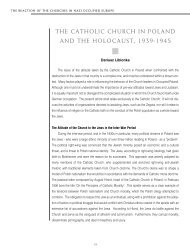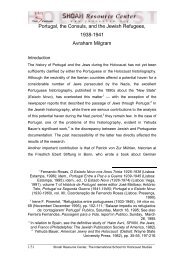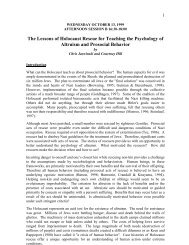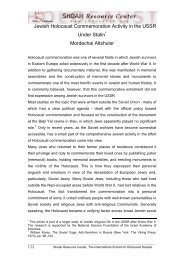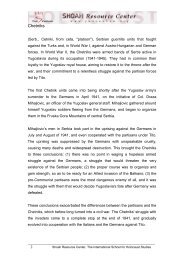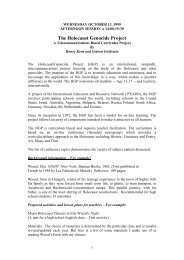Microsoft Word - Yad Vashem
Microsoft Word - Yad Vashem
Microsoft Word - Yad Vashem
You also want an ePaper? Increase the reach of your titles
YUMPU automatically turns print PDFs into web optimized ePapers that Google loves.
MAUTHAUSEN<br />
Concentration camp located near an unused stone quarry about three miles<br />
from the town of Mauthausen in Upper Austria. Mauthausen was opened in<br />
August 1938, just a few months after the Anschluss---the annexing of Austria<br />
by Germany. The first prisoners to arrive were forced to build the camp and<br />
work in the quarry. The work in the quarry proved deadly for many inmates.<br />
During its opening year, the 1,100 prisoners brought to Mauthausen were<br />
common criminals, people deemed "asocial" and unfit to live in German<br />
society, and political opponents of the Reich, including a group of political<br />
prisoners transferred from Dachu. Throughout the war, the camp was mainly<br />
used for political or ideological opponents of the Nazi regime.<br />
Mauthausen was divided into three sections: the prison camp, the<br />
administrative area, and SS housing. The prison camp was Mauthausen's<br />
main area, and it itself was made up of three sections. The prisoners lived in<br />
the 20 huts of Camp No. 1. Each hut was supposed to hold only 300<br />
prisoners, but in most cases more than 600 were jammed in. Four of the huts<br />
were quarantine huts, where new prisoners lived for three weeks. Afterwards,<br />
they were moved into other huts. Camp No. 2 was a workshop area that<br />
contained four huts. From the beginning of 1944, it was also a quarantine<br />
area. Camp No. 3, built in the spring of 1944, originally contained six huts.<br />
Beginning in the summer of 1944, sick and weak prisoners were brought there<br />
before being killed.<br />
The camp complex was guarded by the brutal SS death's head units.<br />
Prisoners held various positions of authority, such as camp elder, the elder's<br />
deputies, and camp registrar. The work in the camp was overseen by Kapos<br />
and the camp blocks were handled by the block elder, block registrar, and<br />
room elders. All of the prisoners in authority positions were given special<br />
privileges.<br />
Until World War II broke out, Mauthausen was similar to other concentration<br />
camps in Germany: mostly German prisoners were made to do terribly harsh<br />
forced labor, but besides that, the conditions at the camp were not so brutal.<br />
When the war started, things changed at Mauthausen. It expanded to become<br />
both a concentration camp and a killing center for political and ideological<br />
__________________________________________________________________________<br />
Shoah Resource Center, The International School for Holocaust Studies<br />
3
opponents from within the Reich and from other Nazi-occupied countries.<br />
Food rations were decreased and the prisoners lived in terribly crowded and<br />
unsanitary conditions. This led to the outbreak of typhus and dysentery<br />
epidemics, weakening and killing many.<br />
By the end of 1939, the camp had more than doubled its prisoner population<br />
to 2,666. During 1940, the number of arriving prisoners grew exponentially:<br />
about 11,000 new inmates were sent to Mauthausen that year, leading the<br />
camp authorities to establish the first of several satellite camps nearby.<br />
Among the prisoners who arrived in 1940 was a group of Republican<br />
Spaniards who had fled SPAIN after General Francisco Franco won the<br />
Spanish Civil War. They had sought refuge in France only to be arrested there<br />
by the Nazis after the German invasion in May 1940.<br />
A total of 18,000 new prisoners arrived at Mauthausen in 1941, including the<br />
camp's first group of Jews, who came in May from the Netherlands. Other<br />
new arrivals included many new Spanish prisoners, Czech political prisoners,<br />
and more than 4,000 Soviet prisoners of war. Most of the Czech prisoners<br />
were murdered that summer, in retaliation for the death of SS leader Reinhard<br />
Heidrych at the hands of Czech resistance fighters. The Soviet prisoners lived<br />
in separate huts called the "Russian camp." Despite the large number of<br />
incoming prisoners, there were only 11,135 left by the end of 1941 due to the<br />
camp's extremely high mortality rate.<br />
In 1942, in addition to more prisoners from the Netherlands, the SOVIET<br />
UNION, Czechoslovakia, and Yugoslavia, transports also arrived from France,<br />
Belgium, Greece, and Luxmbourg. During 1943, 21,028 new internees arrived<br />
from all over Europe. Only a few were Jews. That year, more than 8,000<br />
prisoners died in Mauthausen and its sub-camp, Gusen.<br />
So many new prisoners arrived in 1944 that the German authorities ordered<br />
the construction of several satellite camps to control the overflow. Altogether,<br />
more than 65,000 new prisoners were recorded, and the maximum population<br />
that year was 114,524. In May 1944 Mauthausen admitted large transports of<br />
Jews from AUSCHWITZ. The number of Jews who died in Mauthausen that year<br />
topped 3,000. Many groups of Poles also arrived in Mauthausen in 1944, after<br />
__________________________________________________________________________<br />
Shoah Resource Center, The International School for Holocaust Studies<br />
3
the Warsaw Polish Uprising was put down in October 1944. Many Polish<br />
students and underground members were killed soon after they arrived.<br />
Almost 25,000 new prisoners came to Mauthausen in 1945, including a<br />
stream of Jewish prisoners from Hungary who had been previously interned in<br />
camps along the Austrian-Hungarian border, where they had been forced to<br />
build a line of fortifications. As the battle front drew closer, their camps were<br />
emptied out and the prisoners were marched on foot to Mauthausen. Many<br />
died en route.<br />
The Jews interned in Mauthausen were treated much worse than the other<br />
prisoners. They were forced to dig tunnels at the sub-camps for underground<br />
ammunition factories and were expected to do so at an unbearably fast pace.<br />
After a month or so, the Jewish workers were so physically broken and<br />
exhausted they could hardly move.<br />
On May 3, 1945 a police unit from Vienna took over the camp's security.<br />
The next day, all work stopped at the camp and the SS officers left. On May 5<br />
American troops arrived and liberated the camp. Altogether, 199,404<br />
prisoners passed through Mauthausen. Approximately 119,000 of them,<br />
including 38,120 Jews, were killed or died from the harsh conditions,<br />
exhaustion, malnourishment, and overwork. That number also included the<br />
sick, weak, and "undesirable" prisoners who were taken to the nearby<br />
Hartheim castle to be exterminated in the gas chamber there during the<br />
periods of August 1941 to October 1942 and April to December 1944.<br />
__________________________________________________________________________<br />
Shoah Resource Center, The International School for Holocaust Studies<br />
3




